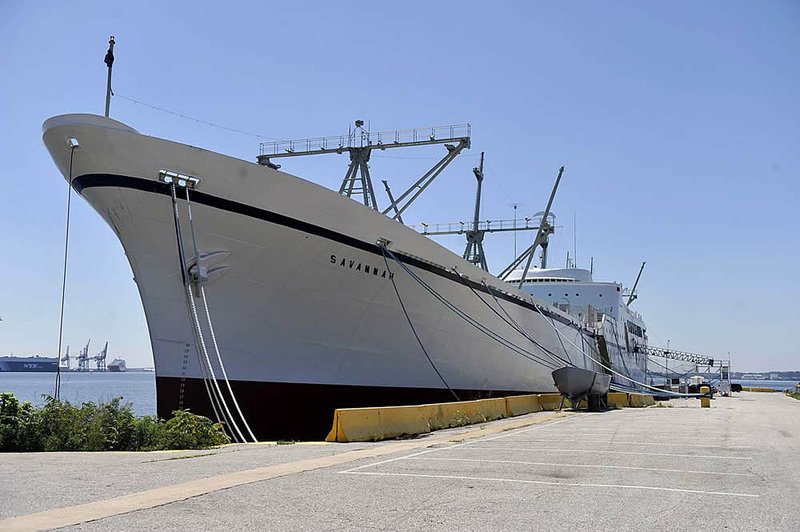BALTIMORE — Tucked behind a ruined grain elevator at a pier along an industrial stretch of Baltimore’s waterfront lies a still-gleaming white vessel that was once one of the nation’s proudest maritime achievements — the only nuclear cargo and passenger ship ever built in the United States.
It’s the N.S. Savannah, a floating time capsule from the mid-20th century that has made Baltimore its retirement home.
For a few brief years during the Kennedy and Johnson administrations the ship was a nautical superstar, touring the world as an ambassador for the peaceful use of nuclear energy and playing host to royalty.
“She was a very interesting ship ... in her time,” said former U.S. Rep. Helen Delich Bentley, who as The Baltimore Sun’s maritime editor wrote about the Savannah in the ship’s heyday. “She was really the grande dame on the oceans.”
The Savannah is not a floating museum nor a tourist attraction. It is berthed at an out-of-the-way Pier 13, wedged between a coal terminal and a gypsum plant that combine to keep the vessel coated with layers of black and white dust.
Still owned and maintained by the Federal Maritime Administration and regulated by the Nuclear Regulatory Commission, the ship is opened to visitors on occasions such as the Maritime Day celebration each May. Groups can arrange tours by request, as long as they don’t expect too much in the way of air conditioning, elevators or other modern creature comforts.
Some of the ship’s fans dream of turning it into an active cultural and educational treasure, but so far nobody has figured out where the money would come from.
Erhard Koehler, the ship’s programs manager and fulltime cheerleader, said the Savannah is the only U.S. vessel ever to have borne the prefix N.S., for nuclear ship, though a few other countries also had such ships. He said the vessel was conceived in 1955 by President Dwight D. Eisenhower to promote his vision of a world in which nuclear power was put to nonmilitary use — a program known as Atoms for Peace.
“It was the one thing in the program that fulfilled Eisenhower’s vision to promote peaceful uses of nuclear power to the world,” said Koehler, who has worked aboard the ship since 1993.
Koehler said nuclear power production was discontinued in 1971 when the ship was taken out of service. Residual radioactivity levels are very low, he said, even though the facility will remain under a regulatory regimen that applies to nuclear power plants until 2031.
“Low risk does not mean no risk,” he said. “We always treat this facility with a healthy respect.”
The Savannah, a sleek 595 1/2 feet long and 78 feet wide, was built at a cost of $47.6 million, or about $360 million in today’s dollars. Intended to be the Atoms for Peace flagship, it was named after the S.S. Savannah, which in 1819 became the first ship to cross the Atlantic using steam power.
The N.S. Savannah was built in the shipyards of Camden, N.J.
The Savannah was never intended to make money, Koehler said. He said Eisenhower personally directed that it be designed with aesthetics rather than profitability in mind. To that end, the designers installed fewer booms than on a conventional cargo ship — complicating loading and unloading but preserving the vessel’s clean lines.
The ship made its maiden voyage in 1962. Now, a visitor touring it enters the era of the Rat Pack and Jackie Kennedy’s pillbox hats, with Jetsons-style furniture and ceiling lamps with atomic power symbols worked into the design. Some artifacts of the era are amazingly well preserved, such as the bar in the passenger lounge and a collection of the ship’s china. Others are in serious disrepair, such as the upholstery in the passenger dining room.
But with only 60 spaces, there weren’t enough passengers to run the service at a profit, Koehler said. After three years, he said, the Maritime Administration got out of the cruise business and hauled cargo only.
During its roughly nine years in cargo service, the ship made calls at 45 foreign ports, including cities in northern Europe, the Mediterranean and Asia, Koehler said. However, some ports remained closed to the ship because of local skittishness about nuclear power — especially in Japan, Australia and New Zealand.
By 1970, the Nixon administration decided there was no further need to subsidize a money-losing demonstration project. The Savannah was taken out of service, and America’s nuclear-powered merchant shipping was consigned to history’s dustbin.
Retirement hasn’t been easy on the Savannah. In 1972, it was moved to the city for which it was named to be part of an Eisenhower memorial. But maintenance costs were too high, and the ship wound up in a Charleston, S.C., maritime museum. Its museum career ended in 1994 and it was mothballed. By 2008, the Maritime Administration was looking for a new home for the ship and Baltimore was chosen, Koehler said. The maritime agency’s lease there continues through May 2016. After that the government would have to open the contract up to new bids.
Federal Maritime Administrator David Matsuda said the agency hopes the ship can be preserved after its nuclear license expires in 2031. Options include continued federal ownership, donation to a private entity or a public-private partnership. Given the vessel’s historical status, it is unlikely to be scrapped, he said.
Business, Pages 66 on 08/07/2011
